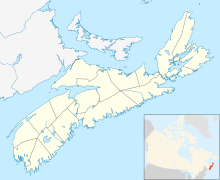Fisher's Grant 24G facts for kids
Fisher's Grant 24G is a special place in Pictou County, Nova Scotia. It is a reserve that belongs to the Mi'kmaq First Nation. This area is managed by the Pictou Landing First Nation, which is a self-governing Mi'kmaq community.
Contents
What is a First Nation Reserve?
A First Nation reserve is a piece of land set aside for the use and benefit of a specific First Nation community. These lands are protected by the Canadian government for Indigenous peoples. Reserves help First Nations keep their culture, traditions, and way of life strong. They are places where communities can live, work, and govern themselves.
Location of Fisher's Grant 24G
Fisher's Grant 24G is located in the beautiful province of Nova Scotia, on Canada's east coast. It is found within Pictou County, which is known for its rich history and coastal areas. The reserve is situated near the town of Pictou, close to the Northumberland Strait. This area has a mix of forests, rivers, and coastal landscapes.
The Mi'kmaq People and Their History
The Mi'kmaq are one of the oldest Indigenous peoples in Canada. Their traditional territory, called Mi'kma'ki, covers all of Nova Scotia, Prince Edward Island, and parts of New Brunswick, Quebec, and Newfoundland. The Mi'kmaq have lived in this region for thousands of years. They have a rich history, unique language, and strong cultural traditions.
Pictou Landing First Nation Community
Fisher's Grant 24G is home to members of the Pictou Landing First Nation. This community is an important part of the larger Mi'kmaq Nation. The Pictou Landing First Nation has its own elected Chief and Council, who work to govern the community. They make decisions about things like education, housing, health, and cultural programs. The community works hard to preserve its Mi'kmaq language, stories, and ceremonies.
Daily Life and Activities
Life in Fisher's Grant 24G involves a mix of traditional and modern ways. Many young people attend local schools, and the community often has programs to support their education and well-being. There are opportunities for sports, cultural events, and community gatherings. These events help connect people and keep Mi'kmaq traditions alive. For example, powwows and cultural workshops are often held to celebrate their heritage.
Protecting the Environment
The Pictou Landing First Nation has a deep connection to the land and water. They are very active in protecting the environment around their reserve. For many years, the community has worked to clean up Boat Harbour, a nearby estuary that was polluted by industrial waste. This effort shows their strong commitment to caring for their traditional lands and waters for future generations. Their work is an example of environmental leadership.
Historical Background of Reserves
The idea of reserves in Canada came from treaties and agreements between Indigenous peoples and the Crown (the government). These agreements were often made to share land and resources. Over time, reserves became specific areas where First Nations could live and maintain their distinct identities. The history of reserves is complex, but they remain important places for First Nations communities today. They are places where Indigenous rights and cultures are upheld.


